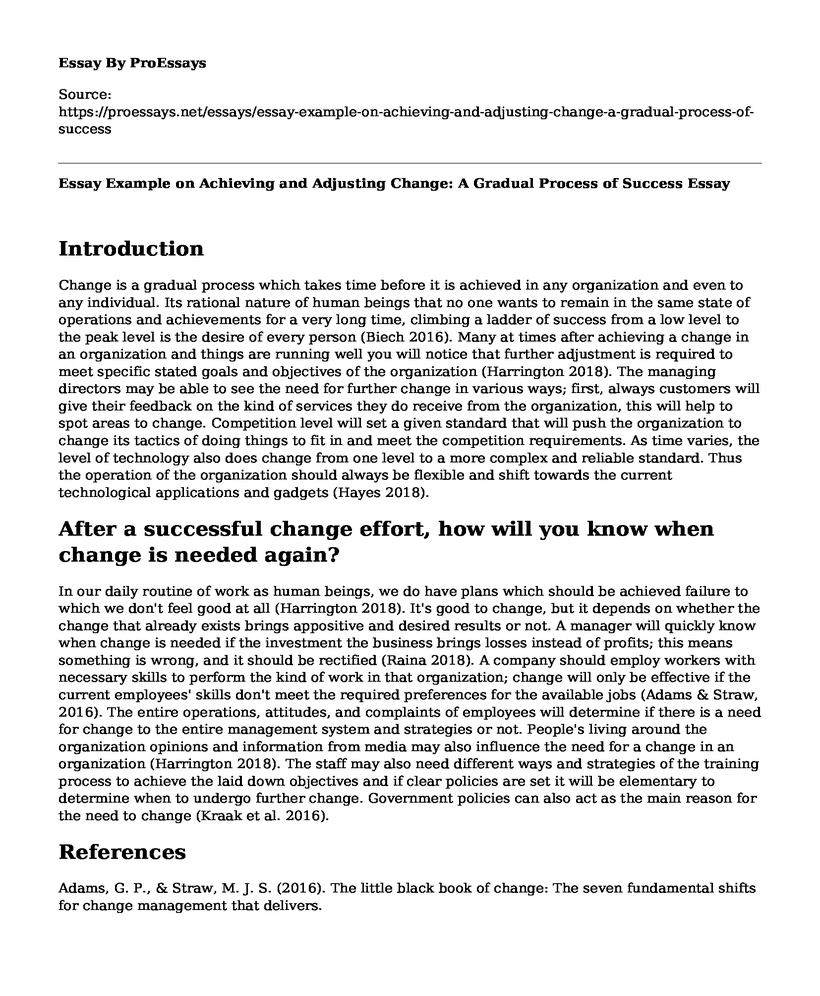Introduction
Change is a gradual process which takes time before it is achieved in any organization and even to any individual. Its rational nature of human beings that no one wants to remain in the same state of operations and achievements for a very long time, climbing a ladder of success from a low level to the peak level is the desire of every person (Biech 2016). Many at times after achieving a change in an organization and things are running well you will notice that further adjustment is required to meet specific stated goals and objectives of the organization (Harrington 2018). The managing directors may be able to see the need for further change in various ways; first, always customers will give their feedback on the kind of services they do receive from the organization, this will help to spot areas to change. Competition level will set a given standard that will push the organization to change its tactics of doing things to fit in and meet the competition requirements. As time varies, the level of technology also does change from one level to a more complex and reliable standard. Thus the operation of the organization should always be flexible and shift towards the current technological applications and gadgets (Hayes 2018).
After a successful change effort, how will you know when change is needed again?
In our daily routine of work as human beings, we do have plans which should be achieved failure to which we don't feel good at all (Harrington 2018). It's good to change, but it depends on whether the change that already exists brings appositive and desired results or not. A manager will quickly know when change is needed if the investment the business brings losses instead of profits; this means something is wrong, and it should be rectified (Raina 2018). A company should employ workers with necessary skills to perform the kind of work in that organization; change will only be effective if the current employees' skills don't meet the required preferences for the available jobs (Adams & Straw, 2016). The entire operations, attitudes, and complaints of employees will determine if there is a need for change to the entire management system and strategies or not. People's living around the organization opinions and information from media may also influence the need for a change in an organization (Harrington 2018). The staff may also need different ways and strategies of the training process to achieve the laid down objectives and if clear policies are set it will be elementary to determine when to undergo further change. Government policies can also act as the main reason for the need to change (Kraak et al. 2016).
References
Adams, G. P., & Straw, M. J. S. (2016). The little black book of change: The seven fundamental shifts for change management that delivers.
Biech, E. (2016). Change management training.
Harrington, H. J. (2018). Innovative Change Management (ICM): Preparing Your Organization for the New Innovative Culture.
Hayes, J. (2018). The Theory and Practice of Change Management.
In Kraak, A., In Paterson, A., & In Boka, K. (2016). Change management in TVET colleges: Lessons learned from the field of practice.
Raina, R. (2018). Change management and organizational development.
Cite this page
Essay Example on Achieving and Adjusting Change: A Gradual Process of Success. (2023, Jan 02). Retrieved from https://proessays.net/essays/essay-example-on-achieving-and-adjusting-change-a-gradual-process-of-success
If you are the original author of this essay and no longer wish to have it published on the ProEssays website, please click below to request its removal:
- The Importance of Leadership in Effective Business Management
- Management Essay Example: Effective Change Agents in Organizations
- A Summary of the Article "Leadership That Gets Results"
- Strategies of Inclusive Leadership and Unlocking the Diversity Potential Paper Example
- The Bright Happy Learning Day Care Company Analysis Paper Example
- The Story Behind Each Cup of Coffee Essay Example
- Essay Example on The Social Responsibility of Companies in the 21st Century







